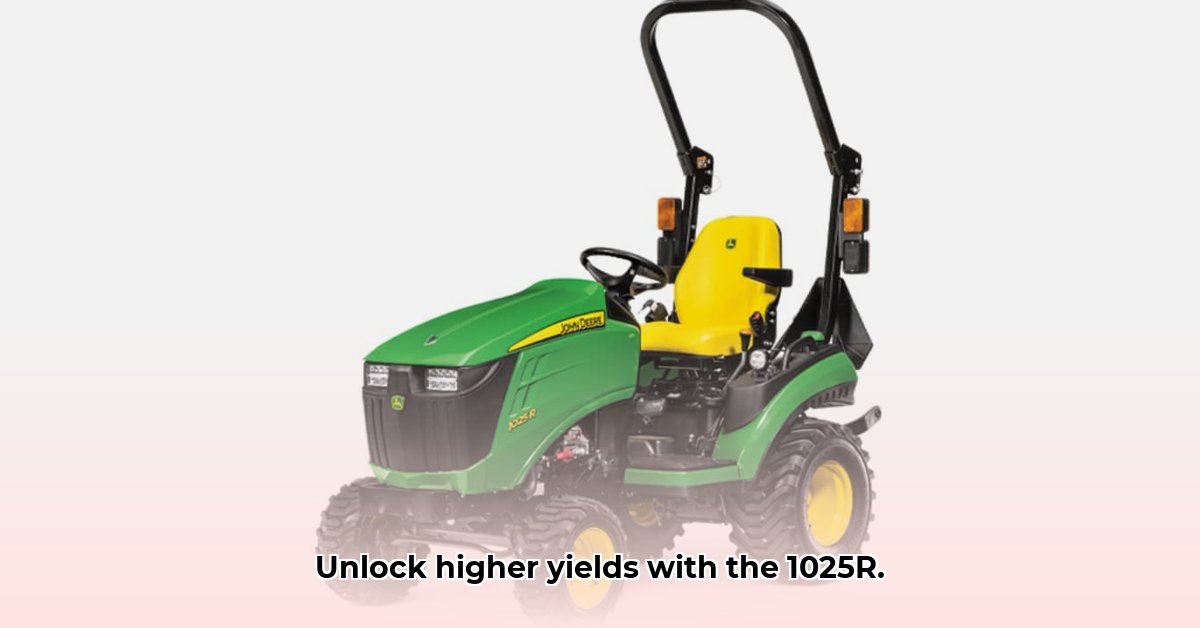
Understanding the John Deere 1025R for Sustainable Agriculture
This guide helps you determine if the John Deere 1025R is the right tractor for your sustainable farming operation. We'll explore its key features, its contribution to environmentally friendly practices, and provide practical advice for maximizing its efficiency. Is the 1025R's compact design and fuel efficiency a better fit than larger, more powerful models for your specific needs? Let's find out. For more information on tractor values, check out this helpful resource: tractor values.
Key Features and Specifications: A Compact Powerhouse
The 1025R is a compact tractor ideal for smaller farms or homesteads prioritizing maneuverability. Its 23.8 horsepower engine provides ample power for various small-scale farming tasks without excessive fuel consumption. Isn't efficient fuel usage a cornerstone of sustainable farming? The hydrostatic transmission allows for smooth speed and direction adjustments without a clutch, enhancing precision, especially around delicate crops or on uneven terrain.
Its key specifications include:
- Engine Horsepower: 23.8 hp
- Lift Capacity: 681 lbs
- Width: 47 inches
This compact design (47 inches wide) minimizes soil compaction, crucial for long-term soil health. The quick-attach implement system facilitates swift transitions between tasks, boosting efficiency. Imagine the time saved transitioning from tilling to mowing! The comfortable operator station contributes to reduced operator fatigue, promoting consistent productivity.
Sustainability in Action: Eco-Friendly Farming Practices
The 1025R directly supports sustainable farming through several key features. Its fuel efficiency results in lower operating costs and a significantly reduced carbon footprint compared to larger tractors. How much fuel do you save annually with a fuel-efficient tractor? The reduced soil compaction from its compact size preserves soil structure, improves water retention and nutrient cycling, and fosters a healthier ecosystem. The tractor's maneuverability enables precise operations, minimizing waste and further reducing fuel usage. Its versatility supports diverse sustainable practices—from planting cover crops to implementing precision agricultural techniques. However, it's crucial to recognize the limitations: its lower horsepower and lift capacity may restrict some intensive tasks.
Practical Application Guide: Optimizing Your Workflow
This section translates the 1025R's capabilities into actionable steps for your farm.
Step 1: Needs Assessment: Before selecting implements, analyze your farming tasks. What are your most time-consuming operations? Where could mechanization provide the most benefit? This initial assessment ensures the 1025R is utilized effectively and efficiently.
Step 2: Implement Selection: Choose implements compatible with the 1025R's 681 lb lift capacity and 23.8 hp engine. Prioritize quick-attach implements to minimize downtime between tasks. Consider implements promoting minimal environmental impact, such as no-till seeders.
Step 3: Workflow Optimization: Group similar tasks together to minimize implement changes. This streamlined approach increases efficiency and frees up time for other essential farm activities. Wouldn’t a more efficient workflow free up more time for other tasks?
Step 4: Efficient Tilling Technique:
- Soil Analysis: Assess soil composition and moisture. Adjust tilling depth and speed accordingly. Heavy clay soils require shallower passes than lighter soils.
- Implement Choice: Select a tiller appropriate for your soil type.
- Maintenance: Ensure the tiller is sharp. A dull tiller decreases efficiency and requires more power.
Troubleshooting and Maintenance: Maximizing Lifespan
Preventive maintenance is essential for maximizing the 1025R's lifespan and minimizing downtime.
Simplified Maintenance Checklist:
| Task Frequency | Maintenance Task | Notes |
|---|---|---|
| Daily | Fluid level checks (oil, hydraulics, coolant); tire pressure; visual inspection | Early problem detection is crucial. |
| Weekly | Thorough cleaning; check for loose components | Prevents rust and ensures secure operation. |
| Monthly | Change engine oil and filter; inspect air filter | Regular oil changes are paramount for engine longevity. |
| Annually | Consult owner's manual for comprehensive service | This may include fluid replacements and inspection of complex components. |
Basic Troubleshooting: If the engine won't start, check the battery and fuel. If implements aren't responding, examine hydraulic fluid levels and connections. For complex issues, consult a qualified mechanic.
Conclusion: Is the 1025R Right for Your Sustainable Farm?
The John Deere 1025R offers significant advantages for sustainable small-scale farming, particularly its fuel efficiency, maneuverability, and reduced soil compaction. However, its lower horsepower and lift capacity compared to larger tractors limit its suitability for some intensive tasks. By carefully assessing your needs, selecting appropriate implements, and following a proactive maintenance schedule, you can maximize the 1025R's efficiency and contribution to your sustainable farming goals. Remember to always prioritize safety when operating any machinery. Consider its limitations and your specific farming scale before making your decision.